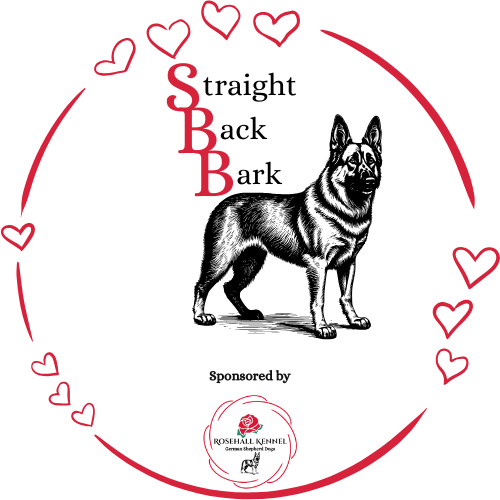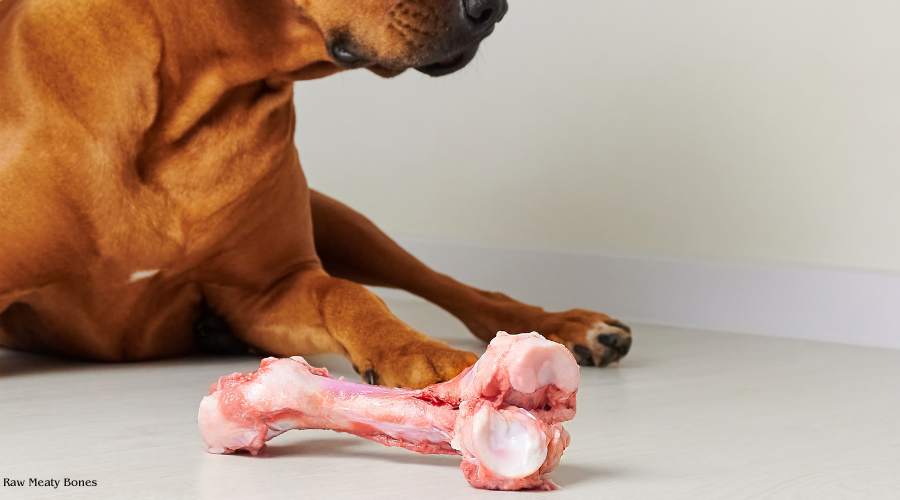If you are considering feeding raw, you can choose from one of two models, or you can create your own diet based loosely on the prey model or bones and raw food (BARF). Both are good diets, though the BARF diet adds foods a carnivorous animal does not usually eat, such as vegetables, nuts and seeds. The biggest factor you need to know is that every dog is different. What works for one dog may not work for another dog. The second factor that is important for you to keep in mind is "Balance over time."
The Prey Model
We will start with the prey model as it is easier and—at least in our circles—more common. This diet does not use fruit, veggies, seeds or nuts, but if you want to do a combination of prey and BARF, you can. For example, many people add a couple of tablespoons of pumpkin or sweet potato to their dogs' daily diet.
What is Included in the Prey Model Diet?
The prey model is based on what dogs would eat in the wild. It's actually whole prey, such as a whole chicken, rabbit or whatever you are feeding. However, that is often not feasible unless you have a very large dog—it's simply too much food for one day for most dogs.
The prey model diet simply consists of the following:
- 80 to 85 percent muscle meat. Muscle meat, skin, connective tissues, fat, hide, hair, and feathers.
- 10 to 15 percent raw meaty bones. Feet, tails, backs, ribs, necks, or a whole carcass.
- 5 to 10 percent organs and offal, half liver. Heart, kidney, liver, pancreas and spleen.
It does not include fruits, vegetables, and dairy, and it does not include excessive supplementation. Prey model feeders believe that domestic dogs should eat the same as their ancestors—wolves.
The stomachs of ruminant animals are also very high in nutrition. Some dogs may eat it if you chunk it up, but it is a very tough and chewy muscle. You know this as tripe, but it's not the white tripe you see in the grocery store. That has been bleached and does not have the nutrients in it. You can buy green tripe in the can, or you can ask hunters to save the deer's stomach.
It is illegal for butchers to sell green tripe, but if you can find a butcher or processor that will save it for you, go for it. If you have a farm and process your own animals, you have a distinct advantage.
You cannot only keep the tripe, but you'll also get other treats, such as lungs and trachea. Most dogs love dried trachea, which is very nutritious. You can provide some of the hard-to-get dietary components by feeding whole prey—the carcass of a deer, a whole rabbit or a whole chicken. Yes, fur, feet and all.
What is Frankenprey?
Most people do not have access to whole animals, so they feed "frankenprey." They piece together what they can from grocery stores. Depending on where you live, you can get a tongue, brain, heart and kidney.
It is enough to feed a mixture of beef, pork, fish and chicken, as long as you have liver in the mix. Some people feed only chicken, and their dogs have lived long lives, but we do not recommend sticking with only one protein, as no one commercially raised protein has all of the nutrients of a well-balanced diet.
A common combination is to feed chicken with beef liver, kidneys and heart. Variety and balance over time are key. The one nutrient that your dog may not get enough of is Omega-3 fatty acids. Some people supplement with this, as grain-fed commercial livestock do not have the proper omega-3 to omega-6 ratios. You can also choose to feed grass-fed animals if the price is not out of reach.
Instead of supplements, you can also feed fatty fish, such as herring, tuna, salmon, mackerel and sardines, for omega-3 fatty acids.
The BARF Diet
This diet is also based on a dog's ancestral diet. However, the theory behind the diet is different, and it adds items that the prey diet does not have. BARF feeders believe that dogs are omnivores instead of carnivores. Others may believe that dogs are carnivores but consider them facultative carnivores. Both advocate adding raw fruits and vegetables to the diet.
The rule of thumb for the BARF diet is:
- 70 percent muscle meat
- 10 percent raw meaty bones
- 5 percent liver
- 5 percent of other organs
- 10 percent fruits, veggies and / or dairy
However, no rule says you have to follow this exactly. If you were to ask 10 people, you'd get 10 different answers. It depends on the person's point of view and their experience feeding their dogs.
What is the Difference Between the Prey Model and BARF?
While both diets believe that raw meat is the focus of the diet, the BARF model can be more forgiving as it allows you to pick and choose what you want. Ground meat, which many prey feeders avoid, is acceptable in the BARF diet.
The BARF diet is also available commercially, though it would be extremely expensive to feed a large dog like a German shepherd the commercially available BARF diet.
It is less restrictive than the prey model, so it is often more appealing to new raw feeders. However, many of the commercially prepared BARF diets contain more bone content, which could lead to chronic constipation in dogs.
How Much Do I Feed My Dog?
The average adult dog eats about two percent of its adult body weight. Puppies eat about four percent of their current body weight. However, that can mean more hassle as you have to weigh your puppy constantly. Many raw feeders simply feed two percent of the dog's estimated adult weight and watch the puppy for unnatural weight gain or loss.
My Pet Carnivore has handy charts you can print out, plus a handy calculator to make it easier. Simply put, start at two percent of your dog's adult weight per day and increase or decrease the amount as needed.
Cautions When Feeding Raw
Feeding your dog raw food has many benefits, including:
- A healthier diet with fewer chemicals
- Smaller poops that tend to dry out and "disappear" within a few days during the warmer months (they hang around longer during the winter months)
- Less "dog" smell
- Softer coat
- Can help dogs with dry skin
Most of all, most dogs love raw. We recommend doing your research on raw diets before you start.
Additional Resources
Most vets and our government do not believe in raw feeding. They employ scare tactics such as food-borne illnesses and not enough nutrients. However, handling raw food for your dogs is no different from handling it for yourself.
Keep your dog's eating area clean, or you can feed outside if you are that concerned. We are providing additional resources to help you further your research.
- Feeding Raw Dog Food: 6 Steps to Getting Started by Dana Scott is an excellent article that goes into how much bone, fat and other items are in the raw diet.
- Benefits of Fresh Dog Food vs. Raw Food vs. Kibble For Your Dog by Ollie Pets, Inc., is a very middle-of-the-road article that discusses cooking fresh food, feeding raw diets and feeding kibble.
- Best Raw Dog Foods by Mike Sagman and Julia Ogden is an article about commercially produced raw food diets on DogFoodAdvisor. This is a go-to site to learn more about the healthiest diets for your dogs, including kibble diets.
These are just a few links to get you started on your research into raw feeding. While you are researching, don't forget that most vets do not like raw feeding and will speak against it. You will find that the CDC and other government sites also hype up salmonella and other food-borne illnesses. However, if you treat your dog's food as you do your own, the risk of getting sick is very low.
** Video above is of Cheryl Bowman's German shepherd, Rambo. He'd been eating raw for some a few years. A neighbor went hunting and gave her the carcass. Rambo ate on that carcass for about a three days. Unfortunately, this was in Florida and it got too warm to leave it out after those few days.





Comments